-
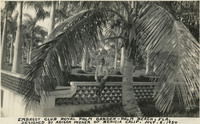 McCarthy Album 11, Photograph 138
McCarthy Album 11, Photograph 138 Caption: "Embassy Club Royal Palm Garden -- Palm Beach, Fla. Designed by Adison [sic] Mizner of Benicia Calif. July 8, 1934." William McCarthy leaning on an ornamental fence in a garden, surrounded by palm trees and manicured hedges. The Embassy Club was a popular Palm Beach club in the mid-twentieth century.
-
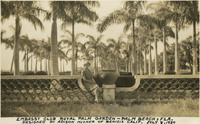 McCarthy Album 11, Photograph 137
McCarthy Album 11, Photograph 137 Caption: "Embassy Club Royal Palm Garden -- Palm Beach, Fla. Designed by Adison [sic] Mizner of Benicia Calif. July 8, 1934." Grace McCarthy sitting on an ornamental fence in a garden, surrounded by palm trees. The Embassy Club was a popular Palm Beach club in the mid-twentieth century.
-
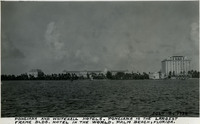 McCarthy Album 11, Photograph 136
McCarthy Album 11, Photograph 136 Caption: "Ponciana [sic] and Whitehall Hotels. Ponciana {sic] is the Largest Frame Bldg. Hotel in the World. Palm Beach, Florida. July 8, 1934." Both the Royal Poinciana Hotel (center) and the Whitehall Hotel (far right) can be seen in this photograph, taken from across Lake Worth. The Royal Poinciana, built by Henry Flagler as a resort retreat for wealthy guests, opened in 1894. Renovations eventually enlarged the hotel to a length of 1,800 feet, with over three miles of corridors and hallways, and rooms for over 1,000 guests. At one point, it was reputed to be the largest wood structure in the world. Attendance declined in the 1920s, however, as tourists were attracted to more modern facilities. Damage by a hurricane and the Great Depression combined to close the hotel in 1934. The building was razed a year later. The Whitehall Hotel started its existence as a mansion, also built by Flagler, as a present for his wife. After Flagler's death in 1913, the home was sold to a group of investors who erected an eleven-story tower and converted the entire complex to use as a resort hotel. In 1959, the Henry Morrison Flagler Museum purchased the building. It now serves as a museum.
-
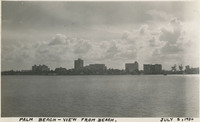 McCarthy Album 11, Photograph 135
McCarthy Album 11, Photograph 135 Caption: "Palm Beach -- View from Beach. July 8, 1934." View of Palm Beach's skyline and waterfront from a beach across the harbor.
-
 McCarthy Album 11, Photograph 134
McCarthy Album 11, Photograph 134 Caption: "An Avenue of Cocoanut [sic] Palms, Palm Beach, Florida, July 8, 1934." Palm trees and manicured hedges line this street in Palm Beach.
-
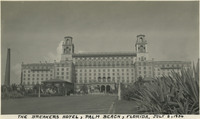 McCarthy Album 11, Photograph 133
McCarthy Album 11, Photograph 133 Caption: "The Breakers Hotel, Palm Beach, Florida. July 8, 1934." The imposing resort hotel shown in this photograph was originally called the Palm Beach Inn when it opened in 1896. The original hotel burned down in 1903, reopened in 1904, and burned again in 1925. After the 1925 fire, the building's owners abandoned wood frame construction in favor of concrete. The new hotel building, as shown in this photograph, was reopened in December 1926.
-
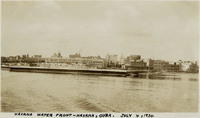 McCarthy Album 11, Photograph 132
McCarthy Album 11, Photograph 132 Caption: "Havana Water Front -- Havana, Cuba. July 4, 1934." View of the waterfront at Havana from across the harbor.
-
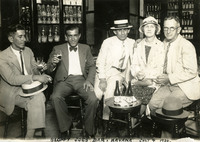 McCarthy Album 11, Photograph 131
McCarthy Album 11, Photograph 131 Caption: "Sloppy Joes Bar, Havana July 4, 1934." William and Grace McCarthy (at the far right) having drinks with three unidentified men in Sloppy Joe's Bar, a drinking establishment owned by Jose Garcia. American tourists flocked to the bar in the 1930s and 1940s, as it attracted illustrious visitors such as John Wayne and Clark Gable. The bar was closed in 1959 after the Cuban revolution.
-
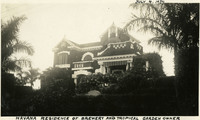 McCarthy Album 11, Photograph 130
McCarthy Album 11, Photograph 130 Caption: "Havana Residence of Brewery and Tropical Garden Owner." Elaborate residence, possibly of a member of the Herrera family, founders of Cuba's first brewery, Cerveceria La Tropical.
-
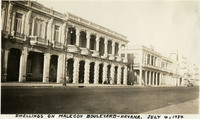 McCarthy Album 11, Photograph 129
McCarthy Album 11, Photograph 129 Caption: "Dwellings on Malecon Boulevard -- Havana. July 4, 1934." The Malecón is a broad esplanade and seawall that extends approximately five miles from Old Havana to the mouth of Havana's harbor. Construction began on the Malecón in 1901, and continued until the early 1950s. This photograph shows several buildings along the Malecón.
-
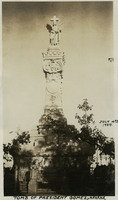 McCarthy Album 11, Photograph 128
McCarthy Album 11, Photograph 128 Caption: "Tomb of President Gomez, Havana. July 4th 1934." José Miguel Gómez y Gómez was instrumental in the Cuban War of Independence (1895-1898), and also served as Cuba's President from 1909-1913. Although he died in New York, his remains were interred in the Colon Cemetery in Havana.
-
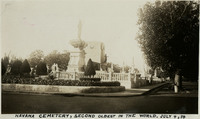 McCarthy Album 11, Photograph 127
McCarthy Album 11, Photograph 127 Caption: "Havana Cemetery, Second Oldest in the World. July 4, 34." Several memorials in Colon Cemetery can be seen in this photograph. Founded in 1876, Colon Cemetery replaced Havana's first cemetery, Espada Cemetery, after a cholera epidemic in 1868 revealed the need for a new, larger facility. Today, the Colon Cemetery holds more than 800,000 graves. It is not known where William McCarthy found reference to this being the "second oldest" cemetery in the world, as California State Archives staff could not verify that statistic.
-
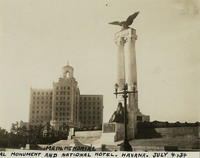 McCarthy Album 11, Photograph 126
McCarthy Album 11, Photograph 126 Caption: "Main [sic] Memorial, ial [sic -- cut off in original photograph] Monument and National Hotel. Havana. July 4, 34." Designed by McKim, Mead and White, the Hotel Nacional in Havana opened in 1930. In the foreground is the Monument to the Victims of the USS Maine, two columns topped by an eagle with outstretched wings, built in 1925 to memorialize the American sailors who died in an explosion on the USS Maine in 1898. The eagle and other features of the monument were removed in 1961 as symbols of imperialism.
-
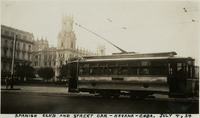 McCarthy Album 11, Photograph 125
McCarthy Album 11, Photograph 125 Caption: "Spanish Club and Street Car -- Havana -- Cuba. July 4, 34." Street Car #116 rolls through the center of this photograph, with one of the elaborate towers of Centro Gallago, now called "Gran Teatro de La Habana," visible in the background.
-
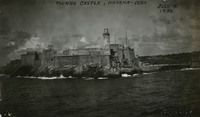 McCarthy Album 11, Photograph 124b
McCarthy Album 11, Photograph 124b Caption: "Morro Castle -- Havana -- Cuba. July 4, 1934." Morro Castle, also called Castillo de los Tres Reyes Magos del Morro, has guarded the entrance to Havana's harbor since 1589. Various additions have been built over the years, including the Faro Castillo del Morro Lighthouse, added in 1846. Morro Castle currently houses the offices of the Havana Harbormaster, and operates as a museum.
-
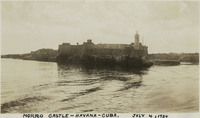 McCarthy Album 11, Photograph 124a
McCarthy Album 11, Photograph 124a Caption: "Morro Castle -- Havana -- Cuba. July 4, 1934." Morro Castle, also called Castillo de los Tres Reyes Magos del Morro, has guarded the entrance to Havana's harbor since 1589. Various additions have been built over the years, including the Faro Castillo del Morro Lighthouse, added in 1846. Morro Castle currently houses the offices of the Havana Harbormaster, and operates as a museum.
-
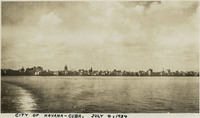 McCarthy Album 11, Photograph 123
McCarthy Album 11, Photograph 123 Caption: "City of Havana -- Cuba. July 4, 1934." View of Havana taken from across a harbor, or other stretch of ocean. The dome of El Capitolio (then Cuba's Capitol) can be seen just to the left of the photograph's center.
-
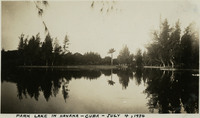 McCarthy Album 11, Photograph 122
McCarthy Album 11, Photograph 122 Caption: "Park Lake in Havana -- Cuba -- July 4, 1934." A calm lake surrounded by trees and other vegetation.
-
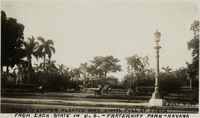 McCarthy Album 11, Photograph 121
McCarthy Album 11, Photograph 121 Caption: "Tree in Center Planted with Shovel Full of Earth From Each State in U.S. -- Fraternity Park -- Havana, July 4, 34." This photograph captures a view of Havana's Fraternity Park. The area originally served the city as a military parade and training ground (called Campo de Marte). In 1928, the park was renovated and a ceiba (or kapok) tree was planted in one of the central parcels. This tree, seen in the center of this photograph, was planted as the Tree of American Fraternity. When Havana hosted the sixth International American Conference later in 1928 (also known as one of the Pan-American Conferences), each of the twenty-one visiting dignitaries brought earth from their native counties in which to plant the tree (William McCarthy mistakenly identified the earth as coming from each state in the U.S.).
-
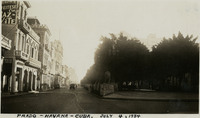 McCarthy Album 11, Photograph 120
McCarthy Album 11, Photograph 120 Caption: "Prado -- Havana -- Cuba. July 4, 1934." Street scene in Havana. A park appears at the right of the photograph, while buildings line the left side of the street.
-
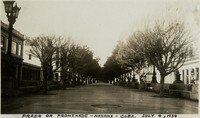 McCarthy Album 11, Photograph 119
McCarthy Album 11, Photograph 119 Caption: "Prado or Promenade -- Havana -- Cub. July 4, 1934." Street scene, with a wide street lined with marble benches and trees on both sides. The Paseo del Prado is the oldest paved street in Havana, marking the line between Centro Habana and Old Havana. Its route was established in 1772 by Don Felipe Fonsdeviela y Ondeano. The street was redesigned in 1925 by landscape architect Jean-Claude Nicolas Forestier (who added the trees and marble benches).
-
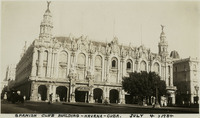 McCarthy Album 11, Photograph 118
McCarthy Album 11, Photograph 118 Caption: "Spanish Club Building -- Havana -- Cuba. July 4, 1934." View of the Centro Gallago, now called "Gran Teatro de La Habana," or "Great Theatre of Havana," completed in 1915. It serves as the headquarters for the Cuban National Ballet Company.
-
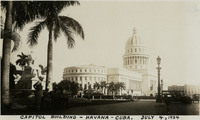 McCarthy Album 11, Photograph 117
McCarthy Album 11, Photograph 117 Caption: "Capitol Building -- Havana -- Cuba. July 4, 1934." The building seen in this photograph, reminiscent of the U.S. Capitol, served as Cuba's Capitol from its completion in 1929 until after the Cuban Revolution of 1959. Designed by Eugenio Rayneri Piedra, the building now houses the Cuban Academy of Sciences.
-
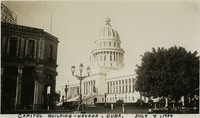 McCarthy Album 11, Photograph 116
McCarthy Album 11, Photograph 116 Caption: "Capitol Building -- Havana, Cuba. July 4, 1934." The building seen in this photograph, reminiscent of the U.S. Capitol, served as Cuba's Capitol from its completion in 1929 until after the Cuban Revolution of 1959. Designed by Eugenio Rayneri Piedra, the building now houses the Cuban Academy of Sciences.
-
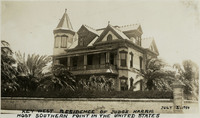 McCarthy Album 11, Photograph 115
McCarthy Album 11, Photograph 115 Caption: "Key West Residence of Judge Harris, Most Southern Point in the United States July 2, 1934." View of the Queen Anne-style Victorian mansion constructed in Key West by Judge Vinning Harris in 1897. The home was originally touted as occupying the southernmost point in the U.S., resulting in the colloquial name "Southernmost House." During the Prohibition years (1920-1933) the house operated as a speakeasy, with a restaurant and casino. In 1939, it was converted to use as a nightclub. Today, it has been renovated for use as a bed-and-breakfast.
-
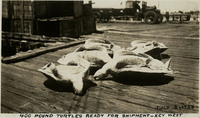 McCarthy Album 11, Photograph 114
McCarthy Album 11, Photograph 114 Caption: "400 Pound Turtles Ready for Shipment -- Key West July 2, 1934." Several slaughtered sea turtles on a wharf in Key West. Turtle meat and eggs were popular food items in the early-to-mid twentieth century; turtle fat was especially prized for making turtle soup. Turtle kraals (corrals) and a cannery were built as the Key West area began to develop. However, the turtle population plummeted in the Florida Keys and surrounding areas as the twentieth century progressed and demand for turtle meat, eggs, and fat increased. The Key West turtle fishing industry halted after the Endangered Species Act was passed in 1971. Turtle populations have since started to recover. The cannery now serves as the Key West Turtle Museum.
-
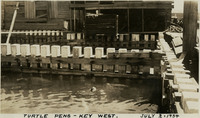 McCarthy Album 11, Photograph 113
McCarthy Album 11, Photograph 113 Caption: "Turtle Pens -- Key West. July 2, 1934." View of turtle kraals, or turtle corrals, used in the turtle fishing industry in Key West. Green turtles were kept in these pens prior to slaughter or transport. Turtle meat and eggs were popular food items in the early-to-mid twentieth century; turtle fat was especially prized for making turtle soup. However, the turtle population plummeted in the Florida Keys and surrounding areas as the twentieth century progressed and demand increased. The turtle kraals and nearby canneries closed when the Endangered Species Act was passed in 1971. Populations have since started to recover. The cannery near the kraals shown in this photograph now serves as the Key West Turtle Museum.
-
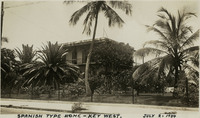 McCarthy Album 11, Photograph 112
McCarthy Album 11, Photograph 112 Caption: "Spanish Type Home -- Key West. July 2, 1934." View of a multi-story residence in Key West. Much of the building is obscured by surrounding vegetation.
-
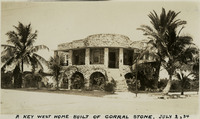 McCarthy Album 11, Photograph 111
McCarthy Album 11, Photograph 111 Caption: "A Key West Home Built of Corral [sic] Stone. July 2, 34." View of a multi-story residence made of coral.
-
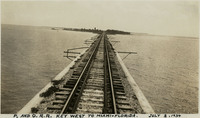 McCarthy Album 11, Photograph 110
McCarthy Album 11, Photograph 110 Caption: "P. and O. R.R. Key West to Miami -- Florida. July 2, 1934." View of railroad tracks running over water to an island in the distance. This is likely part of the Overseas Railroad, an extension of the Florida East Coast Railway, built to connect Key West with the Florida mainland.
-
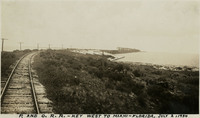 McCarthy Album 11, Photograph 109
McCarthy Album 11, Photograph 109 Caption: "P. and O. R.R. -- Key West to Miami -- Florida. July 2, 1934." View of railroad tracks carried on a berm in the foreground and on a trestle over water in the distance. This is likely part of the Overseas Railroad, an extension of the Florida East Coast Railway, built to connect Key West with the Florida mainland.
-
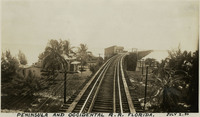 McCarthy Album 11, Photograph 108
McCarthy Album 11, Photograph 108 Caption: "Peninsula and Occidental R.R. Florida. July 2, 34." View of railroad tracks carried over water into the distance on a wood trestle. This is likely part of the Overseas Railroad, an extension of the Florida East Coast Railway, built to connect Key West with the Florida mainland.
-
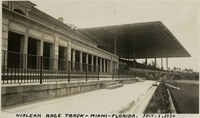 McCarthy Album 11, Photograph 107
McCarthy Album 11, Photograph 107 Caption: "Hialeah Race Track -- Miami -- Florida July 1, 1934." View of the grandstand at Hialeah Park Race Track. Constructed in 1922 as a greyhound racetrack, Hialeah began hosting horse races in 1925. Joseph E. Widener purchased the track in 1930. He embarked upon a series of improvements, adding a grandstand (seen here) and clubhouse facilities designed by Lester W. Geisler, as well as landscaped gardens and a lake in the infield that became home to a flock of flamingos. The new and improved Hialeah track, now called Hialeah Park, officially opened in 1932.
-
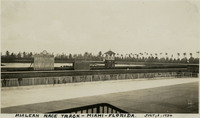 McCarthy Album 11, Photograph 106
McCarthy Album 11, Photograph 106 Caption: "Hialeah Race Track -- Miami -- Florida July 1, 1934." View of the infield at Hialeah Park Race Track. Constructed in 1922 as a greyhound racetrack, Hialeah began hosting horse races in 1925. Joseph E. Widener purchased the track in 1930. He embarked upon a series of improvements, adding a grandstand (seen here) and clubhouse facilities designed by Lester W. Geisler, as well as landscaped gardens and a lake in the infield that became home to a flock of flamingos. The new and improved Hialeah track, now called Hialeah Park, officially opened in 1932.
-
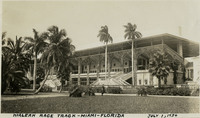 McCarthy Album 11, Photograph 105
McCarthy Album 11, Photograph 105 Caption: "Hialeah Race Track -- Miami -- Florida July 1, 1934." Grace McCarthy standing behind the grandstand at Hialeah Park Race Track, in Hialeah (near Miami). Constructed in 1922 as a greyhound racetrack, Hialeah began hosting horse races in 1925. Joseph E. Widener purchased the track in 1930. He embarked upon a series of improvements, adding a grandstand (seen here) and clubhouse facilities designed by Lester W. Geisler, as well as landscaped gardens and a lake in the infield that became home to a flock of flamingos. The new and improved Hialeah track, now called Hialeah Park, officially opened in 1932.
-
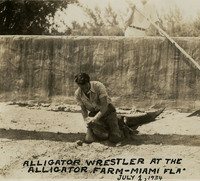 McCarthy Album 11, Photograph 104
McCarthy Album 11, Photograph 104 Caption: "Alligator Wrestler at the Alligator Farm -- Miami Fla. July 1, 1934." Unidentified man kneeling with his knees entrapping an alligator, and holding its mouth closed with his hands.
-
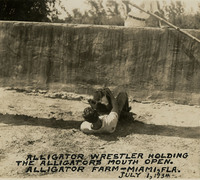 McCarthy Album 11, Photograph 103
McCarthy Album 11, Photograph 103 Caption: "Alligator Wrestler Holding the Alligators Mouth Open. Alligator Farm -- Miami, Fla. July 1, 1934." Unidentified man lying on his back, holding an alligator between his legs and forcing its mouth open to expose its teeth.
-
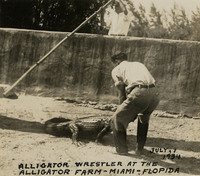 McCarthy Album 11, Photograph 102
McCarthy Album 11, Photograph 102 Caption: "Alligator Wrestler at the Alligator Farm -- Miami -- Flopida [sic] July, [sic] 1 1934." An unidentified man grasps an alligator by the snout in this photograph.
-
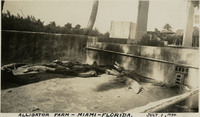 McCarthy Album 11, Photograph 101
McCarthy Album 11, Photograph 101 Caption: "Alligator Farm -- Miami -- Florida. July 1, 1934." View of a holding pen at an alligator farm, with over a dozen alligators sunbathing.
-
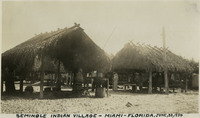 McCarthy Album 11, Photograph 100
McCarthy Album 11, Photograph 100 Caption: "Seminole Indian Village -- Miami -- Florida. June, [sic] 30, 1934." Several shelters with roofs of thatched grass or brush, with several unidentified women and children scattered throughout the photograph. The Seminoles are a Native American tribe from Florida, although most of the tribe had been forcibly relocated from Florida to Oklahoma by 1842. Fewer than 200 remained in Florida after the Third Seminole War ended in 1858, but a resurgence of the tribe occurred in the early to mid twentieth century. The Florida Seminole tribe received federal recognition in 1957.
-
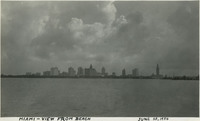 McCarthy Album 11, Photograph 099
McCarthy Album 11, Photograph 099 Caption: "Miami -- View from Beach, June 30, 1934." View of Miami's skyline from across a stretch of ocean. The Miami-Biltmore Hotel can be seen in the center of the photograph, with the Miami-Dade County Courthouse just to its right.
-
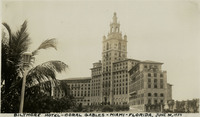 McCarthy Album 11, Photograph 098
McCarthy Album 11, Photograph 098 Caption: "Biltmore Hotel -- Coral Gables -- Miami -- Florida. June 30, 1934." View of the Miami Biltmore Hotel in Coral Gables, part of the Bowman-Biltmore hotel chain. The luxury hotel, designed by Schultze and Weaver, was the tallest building in Florida at the time of its completion in 1926. It held this record until 1928, when the Miami-Dade Courthouse was constructed.
-
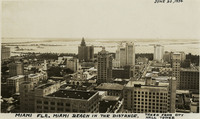 McCarthy Album 11, Photograph 097
McCarthy Album 11, Photograph 097 Caption: "Miami Fla. Miami Beach in the Distance. Taken from City Hall Tower, June 30, 1934." Bird's eye view of Miami, with the ocean in the distance. This photograph was likely taken from atop the Miami-Dade Courthouse rather than City Hall.
-
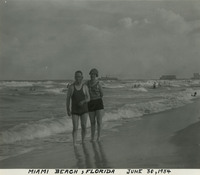 McCarthy Album 11, Photograph 096
McCarthy Album 11, Photograph 096 Caption: "Miami Beach, Florida. June 30 1934." William and Grace McCarthy posing on a beach at the ocean's edge, with surf foaming around their ankles.
-
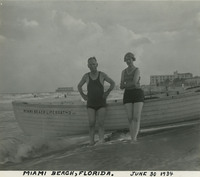 McCarthy Album 11, Photograph 095
McCarthy Album 11, Photograph 095 Caption: "Miami Beach, Florida. June 30 1934." William and Grace McCarthy posing in front of a Miami Beach lifeboat, with surf foaming around their ankles.
-
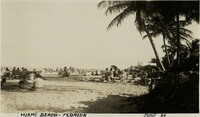 McCarthy Album 11, Photograph 094
McCarthy Album 11, Photograph 094 Caption: "Miami Beach -- Florida, June 30." Crowded beach scene with palm trees at the right and the water in the distance to the left.
-
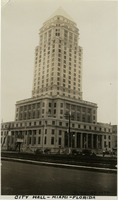 McCarthy Album 11, Photograph 093
McCarthy Album 11, Photograph 093 Caption: "City Hall -- Miami -- Florida, June 30 1934." This photograph depicts the Miami-Dade County Courthouse (not Miami's City Hall). Designed by architect A. Ten Eyck Brown, the Courthouse was constructed between 1925-1928. At the time of its construction, it was the tallest building in Florida.
-
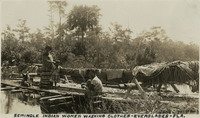 McCarthy Album 11, Photograph 092
McCarthy Album 11, Photograph 092 Caption: "Seminole Indian Women Washing Clothes -- Everglades -- Fla. June 30, 1934." Two unidentified women and a small child washing clothing. Several articles of clothing are spread out to dry on a canoe lifted off the ground by sawhorses made of logs. They are likely Seminoles, a Native American tribe in Florida, although most of the tribe had been forcibly relocated from Florida to Oklahoma by 1842. Fewer than 200 remained in Florida after the Third Seminole War ended in 1858, but a resurgence of the tribe occurred in the early to mid twentieth century. The Florida Seminole tribe received federal recognition in 1957.
-
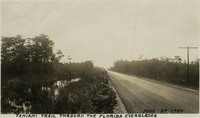 McCarthy Album 11, Photograph 091
McCarthy Album 11, Photograph 091 Caption: "Tamiami Trail Through the Florida Everglades, June 27, 1934." Asphalt-paved road stretching into the distance, flanked on one side by a canal. The Tamiami Trail constitutes a scenic portion of what is now U.S. Highway 41. Work on a road connecting Tampa with Miami began in 1915, but the Trail was not officially opened until 1928. Work on the route required building across a portion of the massive swamp system of the Everglades. Workers dredged and blasted a canal along the route, and used the fill dirt thus removed to construct the roadway proper.
-
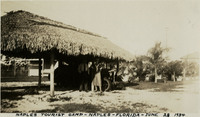 McCarthy Album 11, Photograph 090
McCarthy Album 11, Photograph 090 Caption: "Naples Tourist Camp -- Naples -- Florida -- June 28 1934." William and Grace McCarthy standing near an automobile parked in a thatched shelter.
 McCarthy Album 11, Photograph 138 Caption: "Embassy Club Royal Palm Garden -- Palm Beach, Fla. Designed by Adison [sic] Mizner of Benicia Calif. July 8, 1934." William McCarthy leaning on an ornamental fence in a garden, surrounded by palm trees and manicured hedges. The Embassy Club was a popular Palm Beach club in the mid-twentieth century.
McCarthy Album 11, Photograph 138 Caption: "Embassy Club Royal Palm Garden -- Palm Beach, Fla. Designed by Adison [sic] Mizner of Benicia Calif. July 8, 1934." William McCarthy leaning on an ornamental fence in a garden, surrounded by palm trees and manicured hedges. The Embassy Club was a popular Palm Beach club in the mid-twentieth century. McCarthy Album 11, Photograph 137 Caption: "Embassy Club Royal Palm Garden -- Palm Beach, Fla. Designed by Adison [sic] Mizner of Benicia Calif. July 8, 1934." Grace McCarthy sitting on an ornamental fence in a garden, surrounded by palm trees. The Embassy Club was a popular Palm Beach club in the mid-twentieth century.
McCarthy Album 11, Photograph 137 Caption: "Embassy Club Royal Palm Garden -- Palm Beach, Fla. Designed by Adison [sic] Mizner of Benicia Calif. July 8, 1934." Grace McCarthy sitting on an ornamental fence in a garden, surrounded by palm trees. The Embassy Club was a popular Palm Beach club in the mid-twentieth century. McCarthy Album 11, Photograph 136 Caption: "Ponciana [sic] and Whitehall Hotels. Ponciana {sic] is the Largest Frame Bldg. Hotel in the World. Palm Beach, Florida. July 8, 1934." Both the Royal Poinciana Hotel (center) and the Whitehall Hotel (far right) can be seen in this photograph, taken from across Lake Worth. The Royal Poinciana, built by Henry Flagler as a resort retreat for wealthy guests, opened in 1894. Renovations eventually enlarged the hotel to a length of 1,800 feet, with over three miles of corridors and hallways, and rooms for over 1,000 guests. At one point, it was reputed to be the largest wood structure in the world. Attendance declined in the 1920s, however, as tourists were attracted to more modern facilities. Damage by a hurricane and the Great Depression combined to close the hotel in 1934. The building was razed a year later. The Whitehall Hotel started its existence as a mansion, also built by Flagler, as a present for his wife. After Flagler's death in 1913, the home was sold to a group of investors who erected an eleven-story tower and converted the entire complex to use as a resort hotel. In 1959, the Henry Morrison Flagler Museum purchased the building. It now serves as a museum.
McCarthy Album 11, Photograph 136 Caption: "Ponciana [sic] and Whitehall Hotels. Ponciana {sic] is the Largest Frame Bldg. Hotel in the World. Palm Beach, Florida. July 8, 1934." Both the Royal Poinciana Hotel (center) and the Whitehall Hotel (far right) can be seen in this photograph, taken from across Lake Worth. The Royal Poinciana, built by Henry Flagler as a resort retreat for wealthy guests, opened in 1894. Renovations eventually enlarged the hotel to a length of 1,800 feet, with over three miles of corridors and hallways, and rooms for over 1,000 guests. At one point, it was reputed to be the largest wood structure in the world. Attendance declined in the 1920s, however, as tourists were attracted to more modern facilities. Damage by a hurricane and the Great Depression combined to close the hotel in 1934. The building was razed a year later. The Whitehall Hotel started its existence as a mansion, also built by Flagler, as a present for his wife. After Flagler's death in 1913, the home was sold to a group of investors who erected an eleven-story tower and converted the entire complex to use as a resort hotel. In 1959, the Henry Morrison Flagler Museum purchased the building. It now serves as a museum. McCarthy Album 11, Photograph 135 Caption: "Palm Beach -- View from Beach. July 8, 1934." View of Palm Beach's skyline and waterfront from a beach across the harbor.
McCarthy Album 11, Photograph 135 Caption: "Palm Beach -- View from Beach. July 8, 1934." View of Palm Beach's skyline and waterfront from a beach across the harbor. McCarthy Album 11, Photograph 134 Caption: "An Avenue of Cocoanut [sic] Palms, Palm Beach, Florida, July 8, 1934." Palm trees and manicured hedges line this street in Palm Beach.
McCarthy Album 11, Photograph 134 Caption: "An Avenue of Cocoanut [sic] Palms, Palm Beach, Florida, July 8, 1934." Palm trees and manicured hedges line this street in Palm Beach. McCarthy Album 11, Photograph 133 Caption: "The Breakers Hotel, Palm Beach, Florida. July 8, 1934." The imposing resort hotel shown in this photograph was originally called the Palm Beach Inn when it opened in 1896. The original hotel burned down in 1903, reopened in 1904, and burned again in 1925. After the 1925 fire, the building's owners abandoned wood frame construction in favor of concrete. The new hotel building, as shown in this photograph, was reopened in December 1926.
McCarthy Album 11, Photograph 133 Caption: "The Breakers Hotel, Palm Beach, Florida. July 8, 1934." The imposing resort hotel shown in this photograph was originally called the Palm Beach Inn when it opened in 1896. The original hotel burned down in 1903, reopened in 1904, and burned again in 1925. After the 1925 fire, the building's owners abandoned wood frame construction in favor of concrete. The new hotel building, as shown in this photograph, was reopened in December 1926. McCarthy Album 11, Photograph 132 Caption: "Havana Water Front -- Havana, Cuba. July 4, 1934." View of the waterfront at Havana from across the harbor.
McCarthy Album 11, Photograph 132 Caption: "Havana Water Front -- Havana, Cuba. July 4, 1934." View of the waterfront at Havana from across the harbor. McCarthy Album 11, Photograph 131 Caption: "Sloppy Joes Bar, Havana July 4, 1934." William and Grace McCarthy (at the far right) having drinks with three unidentified men in Sloppy Joe's Bar, a drinking establishment owned by Jose Garcia. American tourists flocked to the bar in the 1930s and 1940s, as it attracted illustrious visitors such as John Wayne and Clark Gable. The bar was closed in 1959 after the Cuban revolution.
McCarthy Album 11, Photograph 131 Caption: "Sloppy Joes Bar, Havana July 4, 1934." William and Grace McCarthy (at the far right) having drinks with three unidentified men in Sloppy Joe's Bar, a drinking establishment owned by Jose Garcia. American tourists flocked to the bar in the 1930s and 1940s, as it attracted illustrious visitors such as John Wayne and Clark Gable. The bar was closed in 1959 after the Cuban revolution. McCarthy Album 11, Photograph 130 Caption: "Havana Residence of Brewery and Tropical Garden Owner." Elaborate residence, possibly of a member of the Herrera family, founders of Cuba's first brewery, Cerveceria La Tropical.
McCarthy Album 11, Photograph 130 Caption: "Havana Residence of Brewery and Tropical Garden Owner." Elaborate residence, possibly of a member of the Herrera family, founders of Cuba's first brewery, Cerveceria La Tropical. McCarthy Album 11, Photograph 129 Caption: "Dwellings on Malecon Boulevard -- Havana. July 4, 1934." The Malecón is a broad esplanade and seawall that extends approximately five miles from Old Havana to the mouth of Havana's harbor. Construction began on the Malecón in 1901, and continued until the early 1950s. This photograph shows several buildings along the Malecón.
McCarthy Album 11, Photograph 129 Caption: "Dwellings on Malecon Boulevard -- Havana. July 4, 1934." The Malecón is a broad esplanade and seawall that extends approximately five miles from Old Havana to the mouth of Havana's harbor. Construction began on the Malecón in 1901, and continued until the early 1950s. This photograph shows several buildings along the Malecón. McCarthy Album 11, Photograph 128 Caption: "Tomb of President Gomez, Havana. July 4th 1934." José Miguel Gómez y Gómez was instrumental in the Cuban War of Independence (1895-1898), and also served as Cuba's President from 1909-1913. Although he died in New York, his remains were interred in the Colon Cemetery in Havana.
McCarthy Album 11, Photograph 128 Caption: "Tomb of President Gomez, Havana. July 4th 1934." José Miguel Gómez y Gómez was instrumental in the Cuban War of Independence (1895-1898), and also served as Cuba's President from 1909-1913. Although he died in New York, his remains were interred in the Colon Cemetery in Havana. McCarthy Album 11, Photograph 127 Caption: "Havana Cemetery, Second Oldest in the World. July 4, 34." Several memorials in Colon Cemetery can be seen in this photograph. Founded in 1876, Colon Cemetery replaced Havana's first cemetery, Espada Cemetery, after a cholera epidemic in 1868 revealed the need for a new, larger facility. Today, the Colon Cemetery holds more than 800,000 graves. It is not known where William McCarthy found reference to this being the "second oldest" cemetery in the world, as California State Archives staff could not verify that statistic.
McCarthy Album 11, Photograph 127 Caption: "Havana Cemetery, Second Oldest in the World. July 4, 34." Several memorials in Colon Cemetery can be seen in this photograph. Founded in 1876, Colon Cemetery replaced Havana's first cemetery, Espada Cemetery, after a cholera epidemic in 1868 revealed the need for a new, larger facility. Today, the Colon Cemetery holds more than 800,000 graves. It is not known where William McCarthy found reference to this being the "second oldest" cemetery in the world, as California State Archives staff could not verify that statistic. McCarthy Album 11, Photograph 126 Caption: "Main [sic] Memorial, ial [sic -- cut off in original photograph] Monument and National Hotel. Havana. July 4, 34." Designed by McKim, Mead and White, the Hotel Nacional in Havana opened in 1930. In the foreground is the Monument to the Victims of the USS Maine, two columns topped by an eagle with outstretched wings, built in 1925 to memorialize the American sailors who died in an explosion on the USS Maine in 1898. The eagle and other features of the monument were removed in 1961 as symbols of imperialism.
McCarthy Album 11, Photograph 126 Caption: "Main [sic] Memorial, ial [sic -- cut off in original photograph] Monument and National Hotel. Havana. July 4, 34." Designed by McKim, Mead and White, the Hotel Nacional in Havana opened in 1930. In the foreground is the Monument to the Victims of the USS Maine, two columns topped by an eagle with outstretched wings, built in 1925 to memorialize the American sailors who died in an explosion on the USS Maine in 1898. The eagle and other features of the monument were removed in 1961 as symbols of imperialism. McCarthy Album 11, Photograph 125 Caption: "Spanish Club and Street Car -- Havana -- Cuba. July 4, 34." Street Car #116 rolls through the center of this photograph, with one of the elaborate towers of Centro Gallago, now called "Gran Teatro de La Habana," visible in the background.
McCarthy Album 11, Photograph 125 Caption: "Spanish Club and Street Car -- Havana -- Cuba. July 4, 34." Street Car #116 rolls through the center of this photograph, with one of the elaborate towers of Centro Gallago, now called "Gran Teatro de La Habana," visible in the background. McCarthy Album 11, Photograph 124b Caption: "Morro Castle -- Havana -- Cuba. July 4, 1934." Morro Castle, also called Castillo de los Tres Reyes Magos del Morro, has guarded the entrance to Havana's harbor since 1589. Various additions have been built over the years, including the Faro Castillo del Morro Lighthouse, added in 1846. Morro Castle currently houses the offices of the Havana Harbormaster, and operates as a museum.
McCarthy Album 11, Photograph 124b Caption: "Morro Castle -- Havana -- Cuba. July 4, 1934." Morro Castle, also called Castillo de los Tres Reyes Magos del Morro, has guarded the entrance to Havana's harbor since 1589. Various additions have been built over the years, including the Faro Castillo del Morro Lighthouse, added in 1846. Morro Castle currently houses the offices of the Havana Harbormaster, and operates as a museum. McCarthy Album 11, Photograph 124a Caption: "Morro Castle -- Havana -- Cuba. July 4, 1934." Morro Castle, also called Castillo de los Tres Reyes Magos del Morro, has guarded the entrance to Havana's harbor since 1589. Various additions have been built over the years, including the Faro Castillo del Morro Lighthouse, added in 1846. Morro Castle currently houses the offices of the Havana Harbormaster, and operates as a museum.
McCarthy Album 11, Photograph 124a Caption: "Morro Castle -- Havana -- Cuba. July 4, 1934." Morro Castle, also called Castillo de los Tres Reyes Magos del Morro, has guarded the entrance to Havana's harbor since 1589. Various additions have been built over the years, including the Faro Castillo del Morro Lighthouse, added in 1846. Morro Castle currently houses the offices of the Havana Harbormaster, and operates as a museum. McCarthy Album 11, Photograph 123 Caption: "City of Havana -- Cuba. July 4, 1934." View of Havana taken from across a harbor, or other stretch of ocean. The dome of El Capitolio (then Cuba's Capitol) can be seen just to the left of the photograph's center.
McCarthy Album 11, Photograph 123 Caption: "City of Havana -- Cuba. July 4, 1934." View of Havana taken from across a harbor, or other stretch of ocean. The dome of El Capitolio (then Cuba's Capitol) can be seen just to the left of the photograph's center. McCarthy Album 11, Photograph 122 Caption: "Park Lake in Havana -- Cuba -- July 4, 1934." A calm lake surrounded by trees and other vegetation.
McCarthy Album 11, Photograph 122 Caption: "Park Lake in Havana -- Cuba -- July 4, 1934." A calm lake surrounded by trees and other vegetation. McCarthy Album 11, Photograph 121 Caption: "Tree in Center Planted with Shovel Full of Earth From Each State in U.S. -- Fraternity Park -- Havana, July 4, 34." This photograph captures a view of Havana's Fraternity Park. The area originally served the city as a military parade and training ground (called Campo de Marte). In 1928, the park was renovated and a ceiba (or kapok) tree was planted in one of the central parcels. This tree, seen in the center of this photograph, was planted as the Tree of American Fraternity. When Havana hosted the sixth International American Conference later in 1928 (also known as one of the Pan-American Conferences), each of the twenty-one visiting dignitaries brought earth from their native counties in which to plant the tree (William McCarthy mistakenly identified the earth as coming from each state in the U.S.).
McCarthy Album 11, Photograph 121 Caption: "Tree in Center Planted with Shovel Full of Earth From Each State in U.S. -- Fraternity Park -- Havana, July 4, 34." This photograph captures a view of Havana's Fraternity Park. The area originally served the city as a military parade and training ground (called Campo de Marte). In 1928, the park was renovated and a ceiba (or kapok) tree was planted in one of the central parcels. This tree, seen in the center of this photograph, was planted as the Tree of American Fraternity. When Havana hosted the sixth International American Conference later in 1928 (also known as one of the Pan-American Conferences), each of the twenty-one visiting dignitaries brought earth from their native counties in which to plant the tree (William McCarthy mistakenly identified the earth as coming from each state in the U.S.). McCarthy Album 11, Photograph 120 Caption: "Prado -- Havana -- Cuba. July 4, 1934." Street scene in Havana. A park appears at the right of the photograph, while buildings line the left side of the street.
McCarthy Album 11, Photograph 120 Caption: "Prado -- Havana -- Cuba. July 4, 1934." Street scene in Havana. A park appears at the right of the photograph, while buildings line the left side of the street. McCarthy Album 11, Photograph 119 Caption: "Prado or Promenade -- Havana -- Cub. July 4, 1934." Street scene, with a wide street lined with marble benches and trees on both sides. The Paseo del Prado is the oldest paved street in Havana, marking the line between Centro Habana and Old Havana. Its route was established in 1772 by Don Felipe Fonsdeviela y Ondeano. The street was redesigned in 1925 by landscape architect Jean-Claude Nicolas Forestier (who added the trees and marble benches).
McCarthy Album 11, Photograph 119 Caption: "Prado or Promenade -- Havana -- Cub. July 4, 1934." Street scene, with a wide street lined with marble benches and trees on both sides. The Paseo del Prado is the oldest paved street in Havana, marking the line between Centro Habana and Old Havana. Its route was established in 1772 by Don Felipe Fonsdeviela y Ondeano. The street was redesigned in 1925 by landscape architect Jean-Claude Nicolas Forestier (who added the trees and marble benches). McCarthy Album 11, Photograph 118 Caption: "Spanish Club Building -- Havana -- Cuba. July 4, 1934." View of the Centro Gallago, now called "Gran Teatro de La Habana," or "Great Theatre of Havana," completed in 1915. It serves as the headquarters for the Cuban National Ballet Company.
McCarthy Album 11, Photograph 118 Caption: "Spanish Club Building -- Havana -- Cuba. July 4, 1934." View of the Centro Gallago, now called "Gran Teatro de La Habana," or "Great Theatre of Havana," completed in 1915. It serves as the headquarters for the Cuban National Ballet Company. McCarthy Album 11, Photograph 117 Caption: "Capitol Building -- Havana -- Cuba. July 4, 1934." The building seen in this photograph, reminiscent of the U.S. Capitol, served as Cuba's Capitol from its completion in 1929 until after the Cuban Revolution of 1959. Designed by Eugenio Rayneri Piedra, the building now houses the Cuban Academy of Sciences.
McCarthy Album 11, Photograph 117 Caption: "Capitol Building -- Havana -- Cuba. July 4, 1934." The building seen in this photograph, reminiscent of the U.S. Capitol, served as Cuba's Capitol from its completion in 1929 until after the Cuban Revolution of 1959. Designed by Eugenio Rayneri Piedra, the building now houses the Cuban Academy of Sciences. McCarthy Album 11, Photograph 116 Caption: "Capitol Building -- Havana, Cuba. July 4, 1934." The building seen in this photograph, reminiscent of the U.S. Capitol, served as Cuba's Capitol from its completion in 1929 until after the Cuban Revolution of 1959. Designed by Eugenio Rayneri Piedra, the building now houses the Cuban Academy of Sciences.
McCarthy Album 11, Photograph 116 Caption: "Capitol Building -- Havana, Cuba. July 4, 1934." The building seen in this photograph, reminiscent of the U.S. Capitol, served as Cuba's Capitol from its completion in 1929 until after the Cuban Revolution of 1959. Designed by Eugenio Rayneri Piedra, the building now houses the Cuban Academy of Sciences. McCarthy Album 11, Photograph 115 Caption: "Key West Residence of Judge Harris, Most Southern Point in the United States July 2, 1934." View of the Queen Anne-style Victorian mansion constructed in Key West by Judge Vinning Harris in 1897. The home was originally touted as occupying the southernmost point in the U.S., resulting in the colloquial name "Southernmost House." During the Prohibition years (1920-1933) the house operated as a speakeasy, with a restaurant and casino. In 1939, it was converted to use as a nightclub. Today, it has been renovated for use as a bed-and-breakfast.
McCarthy Album 11, Photograph 115 Caption: "Key West Residence of Judge Harris, Most Southern Point in the United States July 2, 1934." View of the Queen Anne-style Victorian mansion constructed in Key West by Judge Vinning Harris in 1897. The home was originally touted as occupying the southernmost point in the U.S., resulting in the colloquial name "Southernmost House." During the Prohibition years (1920-1933) the house operated as a speakeasy, with a restaurant and casino. In 1939, it was converted to use as a nightclub. Today, it has been renovated for use as a bed-and-breakfast. McCarthy Album 11, Photograph 114 Caption: "400 Pound Turtles Ready for Shipment -- Key West July 2, 1934." Several slaughtered sea turtles on a wharf in Key West. Turtle meat and eggs were popular food items in the early-to-mid twentieth century; turtle fat was especially prized for making turtle soup. Turtle kraals (corrals) and a cannery were built as the Key West area began to develop. However, the turtle population plummeted in the Florida Keys and surrounding areas as the twentieth century progressed and demand for turtle meat, eggs, and fat increased. The Key West turtle fishing industry halted after the Endangered Species Act was passed in 1971. Turtle populations have since started to recover. The cannery now serves as the Key West Turtle Museum.
McCarthy Album 11, Photograph 114 Caption: "400 Pound Turtles Ready for Shipment -- Key West July 2, 1934." Several slaughtered sea turtles on a wharf in Key West. Turtle meat and eggs were popular food items in the early-to-mid twentieth century; turtle fat was especially prized for making turtle soup. Turtle kraals (corrals) and a cannery were built as the Key West area began to develop. However, the turtle population plummeted in the Florida Keys and surrounding areas as the twentieth century progressed and demand for turtle meat, eggs, and fat increased. The Key West turtle fishing industry halted after the Endangered Species Act was passed in 1971. Turtle populations have since started to recover. The cannery now serves as the Key West Turtle Museum. McCarthy Album 11, Photograph 113 Caption: "Turtle Pens -- Key West. July 2, 1934." View of turtle kraals, or turtle corrals, used in the turtle fishing industry in Key West. Green turtles were kept in these pens prior to slaughter or transport. Turtle meat and eggs were popular food items in the early-to-mid twentieth century; turtle fat was especially prized for making turtle soup. However, the turtle population plummeted in the Florida Keys and surrounding areas as the twentieth century progressed and demand increased. The turtle kraals and nearby canneries closed when the Endangered Species Act was passed in 1971. Populations have since started to recover. The cannery near the kraals shown in this photograph now serves as the Key West Turtle Museum.
McCarthy Album 11, Photograph 113 Caption: "Turtle Pens -- Key West. July 2, 1934." View of turtle kraals, or turtle corrals, used in the turtle fishing industry in Key West. Green turtles were kept in these pens prior to slaughter or transport. Turtle meat and eggs were popular food items in the early-to-mid twentieth century; turtle fat was especially prized for making turtle soup. However, the turtle population plummeted in the Florida Keys and surrounding areas as the twentieth century progressed and demand increased. The turtle kraals and nearby canneries closed when the Endangered Species Act was passed in 1971. Populations have since started to recover. The cannery near the kraals shown in this photograph now serves as the Key West Turtle Museum. McCarthy Album 11, Photograph 112 Caption: "Spanish Type Home -- Key West. July 2, 1934." View of a multi-story residence in Key West. Much of the building is obscured by surrounding vegetation.
McCarthy Album 11, Photograph 112 Caption: "Spanish Type Home -- Key West. July 2, 1934." View of a multi-story residence in Key West. Much of the building is obscured by surrounding vegetation. McCarthy Album 11, Photograph 111 Caption: "A Key West Home Built of Corral [sic] Stone. July 2, 34." View of a multi-story residence made of coral.
McCarthy Album 11, Photograph 111 Caption: "A Key West Home Built of Corral [sic] Stone. July 2, 34." View of a multi-story residence made of coral. McCarthy Album 11, Photograph 110 Caption: "P. and O. R.R. Key West to Miami -- Florida. July 2, 1934." View of railroad tracks running over water to an island in the distance. This is likely part of the Overseas Railroad, an extension of the Florida East Coast Railway, built to connect Key West with the Florida mainland.
McCarthy Album 11, Photograph 110 Caption: "P. and O. R.R. Key West to Miami -- Florida. July 2, 1934." View of railroad tracks running over water to an island in the distance. This is likely part of the Overseas Railroad, an extension of the Florida East Coast Railway, built to connect Key West with the Florida mainland. McCarthy Album 11, Photograph 109 Caption: "P. and O. R.R. -- Key West to Miami -- Florida. July 2, 1934." View of railroad tracks carried on a berm in the foreground and on a trestle over water in the distance. This is likely part of the Overseas Railroad, an extension of the Florida East Coast Railway, built to connect Key West with the Florida mainland.
McCarthy Album 11, Photograph 109 Caption: "P. and O. R.R. -- Key West to Miami -- Florida. July 2, 1934." View of railroad tracks carried on a berm in the foreground and on a trestle over water in the distance. This is likely part of the Overseas Railroad, an extension of the Florida East Coast Railway, built to connect Key West with the Florida mainland. McCarthy Album 11, Photograph 108 Caption: "Peninsula and Occidental R.R. Florida. July 2, 34." View of railroad tracks carried over water into the distance on a wood trestle. This is likely part of the Overseas Railroad, an extension of the Florida East Coast Railway, built to connect Key West with the Florida mainland.
McCarthy Album 11, Photograph 108 Caption: "Peninsula and Occidental R.R. Florida. July 2, 34." View of railroad tracks carried over water into the distance on a wood trestle. This is likely part of the Overseas Railroad, an extension of the Florida East Coast Railway, built to connect Key West with the Florida mainland. McCarthy Album 11, Photograph 107 Caption: "Hialeah Race Track -- Miami -- Florida July 1, 1934." View of the grandstand at Hialeah Park Race Track. Constructed in 1922 as a greyhound racetrack, Hialeah began hosting horse races in 1925. Joseph E. Widener purchased the track in 1930. He embarked upon a series of improvements, adding a grandstand (seen here) and clubhouse facilities designed by Lester W. Geisler, as well as landscaped gardens and a lake in the infield that became home to a flock of flamingos. The new and improved Hialeah track, now called Hialeah Park, officially opened in 1932.
McCarthy Album 11, Photograph 107 Caption: "Hialeah Race Track -- Miami -- Florida July 1, 1934." View of the grandstand at Hialeah Park Race Track. Constructed in 1922 as a greyhound racetrack, Hialeah began hosting horse races in 1925. Joseph E. Widener purchased the track in 1930. He embarked upon a series of improvements, adding a grandstand (seen here) and clubhouse facilities designed by Lester W. Geisler, as well as landscaped gardens and a lake in the infield that became home to a flock of flamingos. The new and improved Hialeah track, now called Hialeah Park, officially opened in 1932. McCarthy Album 11, Photograph 106 Caption: "Hialeah Race Track -- Miami -- Florida July 1, 1934." View of the infield at Hialeah Park Race Track. Constructed in 1922 as a greyhound racetrack, Hialeah began hosting horse races in 1925. Joseph E. Widener purchased the track in 1930. He embarked upon a series of improvements, adding a grandstand (seen here) and clubhouse facilities designed by Lester W. Geisler, as well as landscaped gardens and a lake in the infield that became home to a flock of flamingos. The new and improved Hialeah track, now called Hialeah Park, officially opened in 1932.
McCarthy Album 11, Photograph 106 Caption: "Hialeah Race Track -- Miami -- Florida July 1, 1934." View of the infield at Hialeah Park Race Track. Constructed in 1922 as a greyhound racetrack, Hialeah began hosting horse races in 1925. Joseph E. Widener purchased the track in 1930. He embarked upon a series of improvements, adding a grandstand (seen here) and clubhouse facilities designed by Lester W. Geisler, as well as landscaped gardens and a lake in the infield that became home to a flock of flamingos. The new and improved Hialeah track, now called Hialeah Park, officially opened in 1932. McCarthy Album 11, Photograph 105 Caption: "Hialeah Race Track -- Miami -- Florida July 1, 1934." Grace McCarthy standing behind the grandstand at Hialeah Park Race Track, in Hialeah (near Miami). Constructed in 1922 as a greyhound racetrack, Hialeah began hosting horse races in 1925. Joseph E. Widener purchased the track in 1930. He embarked upon a series of improvements, adding a grandstand (seen here) and clubhouse facilities designed by Lester W. Geisler, as well as landscaped gardens and a lake in the infield that became home to a flock of flamingos. The new and improved Hialeah track, now called Hialeah Park, officially opened in 1932.
McCarthy Album 11, Photograph 105 Caption: "Hialeah Race Track -- Miami -- Florida July 1, 1934." Grace McCarthy standing behind the grandstand at Hialeah Park Race Track, in Hialeah (near Miami). Constructed in 1922 as a greyhound racetrack, Hialeah began hosting horse races in 1925. Joseph E. Widener purchased the track in 1930. He embarked upon a series of improvements, adding a grandstand (seen here) and clubhouse facilities designed by Lester W. Geisler, as well as landscaped gardens and a lake in the infield that became home to a flock of flamingos. The new and improved Hialeah track, now called Hialeah Park, officially opened in 1932. McCarthy Album 11, Photograph 104 Caption: "Alligator Wrestler at the Alligator Farm -- Miami Fla. July 1, 1934." Unidentified man kneeling with his knees entrapping an alligator, and holding its mouth closed with his hands.
McCarthy Album 11, Photograph 104 Caption: "Alligator Wrestler at the Alligator Farm -- Miami Fla. July 1, 1934." Unidentified man kneeling with his knees entrapping an alligator, and holding its mouth closed with his hands. McCarthy Album 11, Photograph 103 Caption: "Alligator Wrestler Holding the Alligators Mouth Open. Alligator Farm -- Miami, Fla. July 1, 1934." Unidentified man lying on his back, holding an alligator between his legs and forcing its mouth open to expose its teeth.
McCarthy Album 11, Photograph 103 Caption: "Alligator Wrestler Holding the Alligators Mouth Open. Alligator Farm -- Miami, Fla. July 1, 1934." Unidentified man lying on his back, holding an alligator between his legs and forcing its mouth open to expose its teeth. McCarthy Album 11, Photograph 102 Caption: "Alligator Wrestler at the Alligator Farm -- Miami -- Flopida [sic] July, [sic] 1 1934." An unidentified man grasps an alligator by the snout in this photograph.
McCarthy Album 11, Photograph 102 Caption: "Alligator Wrestler at the Alligator Farm -- Miami -- Flopida [sic] July, [sic] 1 1934." An unidentified man grasps an alligator by the snout in this photograph. McCarthy Album 11, Photograph 101 Caption: "Alligator Farm -- Miami -- Florida. July 1, 1934." View of a holding pen at an alligator farm, with over a dozen alligators sunbathing.
McCarthy Album 11, Photograph 101 Caption: "Alligator Farm -- Miami -- Florida. July 1, 1934." View of a holding pen at an alligator farm, with over a dozen alligators sunbathing. McCarthy Album 11, Photograph 100 Caption: "Seminole Indian Village -- Miami -- Florida. June, [sic] 30, 1934." Several shelters with roofs of thatched grass or brush, with several unidentified women and children scattered throughout the photograph. The Seminoles are a Native American tribe from Florida, although most of the tribe had been forcibly relocated from Florida to Oklahoma by 1842. Fewer than 200 remained in Florida after the Third Seminole War ended in 1858, but a resurgence of the tribe occurred in the early to mid twentieth century. The Florida Seminole tribe received federal recognition in 1957.
McCarthy Album 11, Photograph 100 Caption: "Seminole Indian Village -- Miami -- Florida. June, [sic] 30, 1934." Several shelters with roofs of thatched grass or brush, with several unidentified women and children scattered throughout the photograph. The Seminoles are a Native American tribe from Florida, although most of the tribe had been forcibly relocated from Florida to Oklahoma by 1842. Fewer than 200 remained in Florida after the Third Seminole War ended in 1858, but a resurgence of the tribe occurred in the early to mid twentieth century. The Florida Seminole tribe received federal recognition in 1957. McCarthy Album 11, Photograph 099 Caption: "Miami -- View from Beach, June 30, 1934." View of Miami's skyline from across a stretch of ocean. The Miami-Biltmore Hotel can be seen in the center of the photograph, with the Miami-Dade County Courthouse just to its right.
McCarthy Album 11, Photograph 099 Caption: "Miami -- View from Beach, June 30, 1934." View of Miami's skyline from across a stretch of ocean. The Miami-Biltmore Hotel can be seen in the center of the photograph, with the Miami-Dade County Courthouse just to its right. McCarthy Album 11, Photograph 098 Caption: "Biltmore Hotel -- Coral Gables -- Miami -- Florida. June 30, 1934." View of the Miami Biltmore Hotel in Coral Gables, part of the Bowman-Biltmore hotel chain. The luxury hotel, designed by Schultze and Weaver, was the tallest building in Florida at the time of its completion in 1926. It held this record until 1928, when the Miami-Dade Courthouse was constructed.
McCarthy Album 11, Photograph 098 Caption: "Biltmore Hotel -- Coral Gables -- Miami -- Florida. June 30, 1934." View of the Miami Biltmore Hotel in Coral Gables, part of the Bowman-Biltmore hotel chain. The luxury hotel, designed by Schultze and Weaver, was the tallest building in Florida at the time of its completion in 1926. It held this record until 1928, when the Miami-Dade Courthouse was constructed. McCarthy Album 11, Photograph 097 Caption: "Miami Fla. Miami Beach in the Distance. Taken from City Hall Tower, June 30, 1934." Bird's eye view of Miami, with the ocean in the distance. This photograph was likely taken from atop the Miami-Dade Courthouse rather than City Hall.
McCarthy Album 11, Photograph 097 Caption: "Miami Fla. Miami Beach in the Distance. Taken from City Hall Tower, June 30, 1934." Bird's eye view of Miami, with the ocean in the distance. This photograph was likely taken from atop the Miami-Dade Courthouse rather than City Hall. McCarthy Album 11, Photograph 096 Caption: "Miami Beach, Florida. June 30 1934." William and Grace McCarthy posing on a beach at the ocean's edge, with surf foaming around their ankles.
McCarthy Album 11, Photograph 096 Caption: "Miami Beach, Florida. June 30 1934." William and Grace McCarthy posing on a beach at the ocean's edge, with surf foaming around their ankles. McCarthy Album 11, Photograph 095 Caption: "Miami Beach, Florida. June 30 1934." William and Grace McCarthy posing in front of a Miami Beach lifeboat, with surf foaming around their ankles.
McCarthy Album 11, Photograph 095 Caption: "Miami Beach, Florida. June 30 1934." William and Grace McCarthy posing in front of a Miami Beach lifeboat, with surf foaming around their ankles. McCarthy Album 11, Photograph 094 Caption: "Miami Beach -- Florida, June 30." Crowded beach scene with palm trees at the right and the water in the distance to the left.
McCarthy Album 11, Photograph 094 Caption: "Miami Beach -- Florida, June 30." Crowded beach scene with palm trees at the right and the water in the distance to the left. McCarthy Album 11, Photograph 093 Caption: "City Hall -- Miami -- Florida, June 30 1934." This photograph depicts the Miami-Dade County Courthouse (not Miami's City Hall). Designed by architect A. Ten Eyck Brown, the Courthouse was constructed between 1925-1928. At the time of its construction, it was the tallest building in Florida.
McCarthy Album 11, Photograph 093 Caption: "City Hall -- Miami -- Florida, June 30 1934." This photograph depicts the Miami-Dade County Courthouse (not Miami's City Hall). Designed by architect A. Ten Eyck Brown, the Courthouse was constructed between 1925-1928. At the time of its construction, it was the tallest building in Florida. McCarthy Album 11, Photograph 092 Caption: "Seminole Indian Women Washing Clothes -- Everglades -- Fla. June 30, 1934." Two unidentified women and a small child washing clothing. Several articles of clothing are spread out to dry on a canoe lifted off the ground by sawhorses made of logs. They are likely Seminoles, a Native American tribe in Florida, although most of the tribe had been forcibly relocated from Florida to Oklahoma by 1842. Fewer than 200 remained in Florida after the Third Seminole War ended in 1858, but a resurgence of the tribe occurred in the early to mid twentieth century. The Florida Seminole tribe received federal recognition in 1957.
McCarthy Album 11, Photograph 092 Caption: "Seminole Indian Women Washing Clothes -- Everglades -- Fla. June 30, 1934." Two unidentified women and a small child washing clothing. Several articles of clothing are spread out to dry on a canoe lifted off the ground by sawhorses made of logs. They are likely Seminoles, a Native American tribe in Florida, although most of the tribe had been forcibly relocated from Florida to Oklahoma by 1842. Fewer than 200 remained in Florida after the Third Seminole War ended in 1858, but a resurgence of the tribe occurred in the early to mid twentieth century. The Florida Seminole tribe received federal recognition in 1957. McCarthy Album 11, Photograph 091 Caption: "Tamiami Trail Through the Florida Everglades, June 27, 1934." Asphalt-paved road stretching into the distance, flanked on one side by a canal. The Tamiami Trail constitutes a scenic portion of what is now U.S. Highway 41. Work on a road connecting Tampa with Miami began in 1915, but the Trail was not officially opened until 1928. Work on the route required building across a portion of the massive swamp system of the Everglades. Workers dredged and blasted a canal along the route, and used the fill dirt thus removed to construct the roadway proper.
McCarthy Album 11, Photograph 091 Caption: "Tamiami Trail Through the Florida Everglades, June 27, 1934." Asphalt-paved road stretching into the distance, flanked on one side by a canal. The Tamiami Trail constitutes a scenic portion of what is now U.S. Highway 41. Work on a road connecting Tampa with Miami began in 1915, but the Trail was not officially opened until 1928. Work on the route required building across a portion of the massive swamp system of the Everglades. Workers dredged and blasted a canal along the route, and used the fill dirt thus removed to construct the roadway proper. McCarthy Album 11, Photograph 090 Caption: "Naples Tourist Camp -- Naples -- Florida -- June 28 1934." William and Grace McCarthy standing near an automobile parked in a thatched shelter.
McCarthy Album 11, Photograph 090 Caption: "Naples Tourist Camp -- Naples -- Florida -- June 28 1934." William and Grace McCarthy standing near an automobile parked in a thatched shelter.